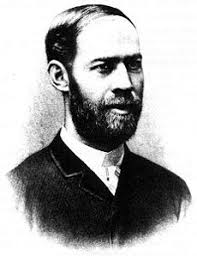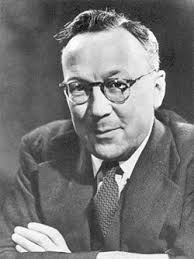Heinrich Hertz
Heinrich Hertz in Germany calculated that an electric current swinging very rapidly back and forth in a conducting wire would radiate electromagnetic waves into the surrounding space (today we would call such a wire an "antenna"). With such a wire he created (in 1886) and detected such oscillations in his lab, using an electric spark, in which the current oscillates rapidly (that is how lightning creates its characteristic crackling noise on the radio!). Today we call such waves "radio waves". At first however they were "Hertzian waves, " and even today we honor the memory of their discoverer by measuring frequencies in Hertz (Hz), oscillations per second--and at radio frequencies, in megahertz (MHz).

 Alexader Watson Watt
Alexader Watson Watt
Heinrich Hertz in Germany calculated that an electric current swinging very rapidly back and forth in a conducting wire would radiate electromagnetic waves into the surrounding space (today we would call such a wire an "antenna"). With such a wire he created (in 1886) and detected such oscillations in his lab, using an electric spark, in which the current oscillates rapidly (that is how lightning creates its characteristic crackling noise on the radio!). Today we call such waves "radio waves". At first however they were "Hertzian waves, " and even today we honor the memory of their discoverer by measuring frequencies in Hertz (Hz), oscillations per second--and at radio frequencies, in megahertz (MHz).
Sir Robert Alexander Watson-Watt (1892--1973)
Watson-Watt was the Scottish physicist who developed the radar locating of aircraft in England. He was born in Brechin, Angus, Scotland, educated at St Andrews University in Scotland, and taught at Dundee University. In 1917, he worked at the British Meteorological Office, where he designed devices to locate thunderstorms. Watson-Watt coined the phrase "ionosphere" in 1926. He was appointed as the director of radio research at the British National Physical Laboratory in 1935, where he completed his research into aircraft locating devices. Watson-Watt's other contributions include a cathode-ray direction finder used to study atmospheric phenomena, research in electromagnetic radiation, and inventions used for flight safety.
- Radar was patented (British patent) in April, 1935.
Christian Andreas Doppler
Doppler RADAR is named after Christian Andreas Doppler. Doppler was an Austrian physicist who first described in 1842, how the observed frequency of light and sound waves was affected by the relative motion of the source and the detector. This phenomenon became known as the Doppler effect.
Dr. Robert Rines
Robert Rines is the inventor of high definition radar and the sonogram, a patent attorney, the founder of the Franklin Pierce Law Center and a chaser of the Loch Ness monster.
Watson-Watt was the Scottish physicist who developed the radar locating of aircraft in England. He was born in Brechin, Angus, Scotland, educated at St Andrews University in Scotland, and taught at Dundee University. In 1917, he worked at the British Meteorological Office, where he designed devices to locate thunderstorms. Watson-Watt coined the phrase "ionosphere" in 1926. He was appointed as the director of radio research at the British National Physical Laboratory in 1935, where he completed his research into aircraft locating devices. Watson-Watt's other contributions include a cathode-ray direction finder used to study atmospheric phenomena, research in electromagnetic radiation, and inventions used for flight safety.
- Radar was patented (British patent) in April, 1935.
Christian Andreas Doppler
Doppler RADAR is named after Christian Andreas Doppler. Doppler was an Austrian physicist who first described in 1842, how the observed frequency of light and sound waves was affected by the relative motion of the source and the detector. This phenomenon became known as the Doppler effect.
This is most often demonstrated by the change in the sound wave of a passing train. The sound of the train whistle will become "higher" in pitch as it approaches and "lower" in pitch as it moves away. This is explained as follows: the number of sound waves reaching the ear in a given amount of time (this is called the frequency) determines the tone, or pitch, perceived. The tone remains the same as long as you are not moving. As the train moves closer to you the number of sound waves reaching your ear in a given amount of time increases. Thus, the pitch increases. As the train moves away from you the opposite happens.
Dr. Robert Rines
Robert Rines is the inventor of high definition radar and the sonogram, a patent attorney, the founder of the Franklin Pierce Law Center and a chaser of the Loch Ness monster.
Heinrich Hertz
Chritian Andreas Doppler.
Sir Robert Rines.


